Washington Nationals: Max Scherzer and the 300-strikeout club

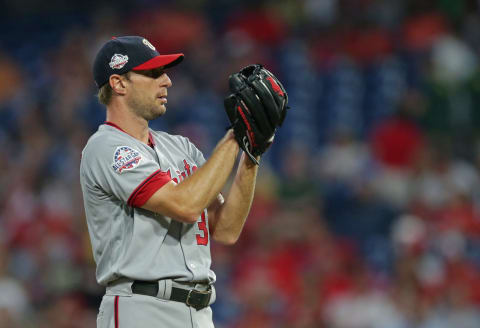
With his 300th strikeout in his recent start, Washington Nationals ace Max Scherzer became just the 17th pitcher in MLB history to join the 300-strikeout club.
When Max Scherzer struck out Austin Dean on Tuesday to notch his 300th strikeout this season for the Washington Nationals, he joined a select group of pitchers to accomplish the feat. In the long history of major league baseball, just 16 pitchers before Scherzer struck out 300 batters in a season. These 16 pitchers did this a combined 35 times. Scherzer makes it 17 pitchers and 36 times.
What Scherzer just accomplished is quite rare. In fact, a pitcher striking out 300 batters in a season is more rare than 50-HR seasons or seasons in which a player had 150 RBI. Here’s a list of single-season feats that have happened a little more or a little less often than a 300-strikeout season.
- 28 times—145 runs scored in a season
- 36 times—300 strikeouts in a season
- 36 times—230 hits in a season
- 41 times—75 stolen bases in a season
- 44 times—150 RBI in a season
- 45 times—50 homers in a season
The first 300-strikeout season was in 1903, when left-handed pitcher Rube Waddell struck out 302 batters in 324 innings. He followed that up with 349 strikeouts in 383 innings in 1904. That would be the major league record for strikeouts in a season until Sandy Koufax topped it in 1965.
Waddell was the original eccentric lefty. He was described as possessing “the intellectual and emotional maturity of a child—although a very precocious and engaging one at that.” He would sometimes fail to show up at the ballpark, even on days he was scheduled to pitch. He had a fascination with fire trucks and was easily distracted by opposing fans who held up puppies.
Recent writers have suggested that Waddell may have had a developmental disability or autism or possibly attention deficit disorder. In those days, he wouldn’t have been diagnosed with any of those, so he was just considered a bit of an odd duck. He was incredibly talented with a baseball in his hand, though, as can be seen by his back-to-back 300-strikeout campaigns. Despite pitching just 13 seasons, Waddell was voted into the Baseball Hall of Fame by the Old Timers Committee in 1946. Waddell was the first to strike out 300 batters in a season, but he had contemporary company.
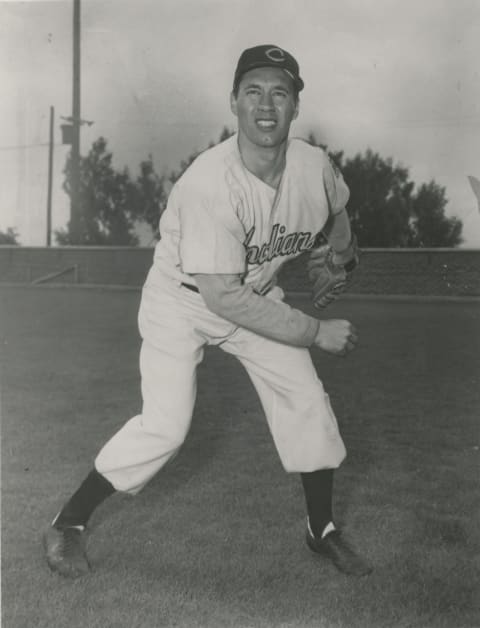
Big Train and Rapid Robert
Six years after Waddell’s second 300-strikeout season, right-handed hurler Walter Johnson had the first of his two 300-strikeout seasons. Johnson struck out 313 batters in 1910 and 303 batters in 1912. Of course, he pitched an incredible 370 and 369 innings in those two seasons, but topping 300 strikeouts was still an impressive and rare feat.
Johnson was the strikeout artist of his time. In addition to his two 300-strikeout seasons that easily led the league, he was tops in strikeouts 10 other times. Johnson was considered the hardest thrower in his day. He was a big man who brought his arm back in a wide arc and slung it to the plate from around chest height. Ty Cobb said of Johnson, “His fastball looked about the size of a watermelon seed and it hissed at you as it passed.”
After Walter Johnson had his two 300-strikeout seasons in 1910 and 1912, no pitcher had 300 strikeouts in the 1920s or the 1930s. In 1946, Bob Feller was in his second season back after missing three years for military service during World War II. He came back with a vengeance when he struck out a career-high and new major league record 348 batters in 371.3 innings.
It was no accident that Feller set the new single-season record for strikeouts. As the whiffs accumulated that season, Feller had his eye on Waddell’s mark. After he set his career-high with his 262nd strikeout in mid-August, Feller decided to shoot for the MLB single-season record of 343. Cleveland was well below .500 as the calendar moved to September, but Feller continued to rack up innings. He started seven of his team’s final 17 games.
In the last two weeks of the season, he started on September 19th, 22nd, 25th, then pitched in relief on September 27th. The final game of the season was on September 29th and Feller was on the bump, tied with Waddell. He struck out five to get the record.
Feller was an anomaly. He had his big season in 1946, more than 30 years after Johnson had last accomplished the feat. Then another 300-strikeout drought ensued, as no pitcher achieved the mark for the rest of the 1940s or the entire decade of the 1950s. Feller was the only pitcher to strike out 300 batters in a season during the 50-year stretch from 1913 to 1962, but two new strikeout stars were about to emerge on the scene.
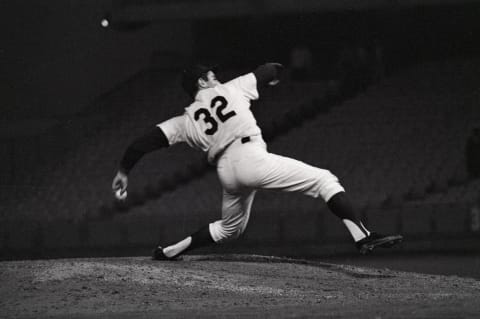
Sandy and Sudden Sam
After just one 300-strikeout season in the previous 50 years, the 300-strikeout season made a comeback in the 1960s. Sandy Koufax struck out 306 batters in 1963 and followed it up two years later by setting a new major league record with 382 strikeouts in 1965. He finished it off with 317 strikeouts in 1966, his final season. Imagine being 31 years old and coming off a season in which you went 27-9 with a 1.73 ERA and 317 strikeouts . . . and retiring. That’s what Koufax did because the pain in his arm was unbearable.
When he retired, Koufax said, “I’ve had a few too many shots and taken a few too many pills. … I had to take a shot every ballgame. That’s more than I wanted to do. I had stomachaches from the pain pills. I’d be high half the time in ballgames from the pills. I don’t want that.” It’s amazing how dominant Koufax was despite the elbow pain he was feeling.
Another big strikeout pitcher during the time Koufax was dominating hitters was Sam McDowell, who struck out 325 batters in 1965 and 304 in 1970. McDowell was a big, left-handed pitcher who led the American League in strikeouts five times in six seasons from 1965 to 1970. He also led the AL in walks five times in seven seasons during that same time. Twice he led the league in strikeouts, walks and wild pitches.
In May of 1966, McDowell was featured in Sports Illustrated. He was on the cover with the caption, “Faster Than Koufax?” It was natural to compare the two. They were both lefties who dominated hitters. Koufax ruled over the National League, while McDowell spent most of his career throwing gas at hitters in the American League. After this duo dominated the 1960s, another group of pitchers would emerge in the 1970s.
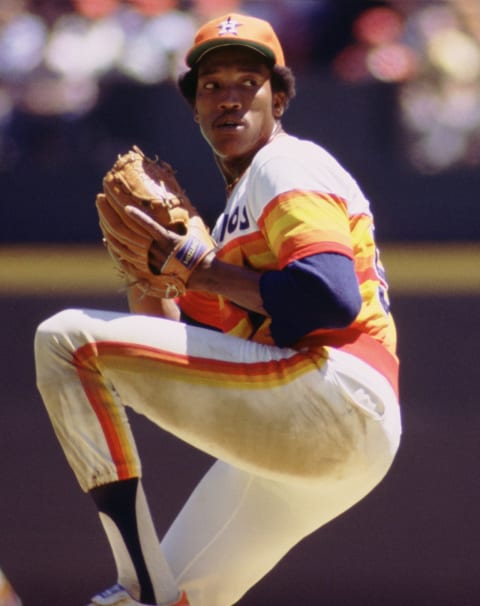
Swing-and-Miss 70s
After McDowell had his 300-strikeout season in 1970, there was a veritable deluge of 300-strikeout seasons. Mickey Lolich and Vida Blue both struck out 300-plus in 1971. Nolan Ryan and Steve Carlton did the same in 1972. Ryan followed that up with a major league record 383 strikeouts in 1973.
Ryan needed 15 strikeouts in his final start of the 1973 season to break Koufax’ mark of 382 strikeouts. It took him 11 innings to do it, but a strikeout of Rich Reese of the Minnesota Twins was the record-setter. Ryan continued to mow down hitters at an incredible pace over the rest of his career. In addition to the 1972 and 1973 seasons, he struck out 300 or more batters in 1974, 1976, 1977 and 1989, when he was 42 years old. Ryan is the King of the K‘s.
The 1970s was a great decade for 300-strikeout pitchers. In addition to the ones named above, there was J.R. Richard in 1978 and 1979. Richard was the Houston Astros’ first round draft pick in the 1969 June Amateur Draft. He was the second player taken in that draft, after Jeff Burroughs of the Washington Senators. A couple other prominent major leaguers taken in that round were pitcher Don Gullett and outfielder Gorman Thomas, who was drafted as a shortstop by the Seattle Pilots but would become a power-hitting outfielder on the Milwaukee Brewers.
It didn’t take long for J.R. Richard to get to the big leagues and he was incredible in his major league debut. On September 5, 1971, he struck out 15 batters in a complete game victory over the San Francisco Giants. Despite his successful first outing, he didn’t establish himself in the Astros rotation until 1975, when he was 12-10 with a 4.39 ERA.
Richard had an incredible arm, but his control was a work in progress. He led the NL in walks and wild pitches three times in five years from 1975 to 1979. He made up for the walks somewhat by limiting hits. He led the league in fewest hits per nine innings three times during this stretch.
Heading into the 1978 season, Richard had established himself as one of the National League’s top pitchers, but he took it up a notch that year by striking out 303 batters in 275.3 innings. He followed that up with 313 strikeouts in 292.3 innings the following year.
On the mound, the six-foot-eight Richard was as intimidating as any pitcher who ever toed the slab. He threw pure fire, with a 100 mph fastball and a 90-plus mph slider. Unfortunately, during the 1980 season, when he was 10-4 with a 1.90 ERA through his first 17 starts, he suffered a stroke that ended his major league career. He’s one of the all-time “what might have been” stories in baseball history. As fate would have it, the next pitcher to top 300 strikeouts in a season would also pitch for Richard’s team, the Houston Astros.
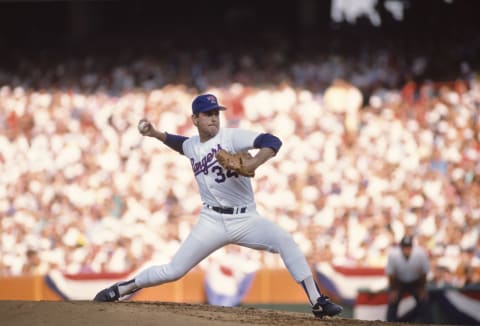
Great Scott and the Ryan Express
After baseball fans saw eleven 300-strikeout seasons in the 1970s, there were only two 300-strikeout seasons in the 1980s. The first of these two was a shocker. Mike Scott was a nondescript right-handed pitcher who came up with the Mets in 1979. After four years in New York, he was traded to the Houston Astros for platoon outfielder Danny Heep.
Scott hadn’t shown much with the Mets early in his career and didn’t show much with the Astros his first two years in Houston. He had his first season with 200 or more innings pitched in 1985, when he was 18-8 with a 3.29 ERA. He struck out 137 batters that year, which was a career-high.
Then, suddenly, Mike Scott went from a ho-hum starting pitcher with a below .500 win-loss record and a career 4.16 ERA to the best pitcher in the National League in 1986. He was 18-10 and led the league in ERA, WHIP, innings pitched, shutouts and strikeouts (2.22 ERA, 0.92 WHIP, 275.3 IP, 5 shutouts, 306 strikeouts). In Game 1 of the NLCS, he struck out 14 Mets on his way to a 1-0 victory.
Scott only had that one 300-strikeout season. In fact, he only had one other season with more than 200 strikeouts. He was still a good pitcher for the three seasons after his great 1986 campaign, but didn’t come close to 300 strikeouts again.
Three years after Scott struck out 306 batters for the Houston Astros, another Texan hit the mark in 1989. Nolan Ryan, pitching for the Texas Rangers, had his sixth (and final) 300-strikeout season. The 42-year-old gunslinger struck out 301 batters in 239.3 innings with the Texas Rangers. His final start that year was the 161st game for the Rangers. Ryan tossed a complete-game, three-hit shutout with no walks and 13 strikeouts to get to 301 for the year. He was the first to have six 300-strikeout seasons, but another guy was on his way who would match Ryan in that department.
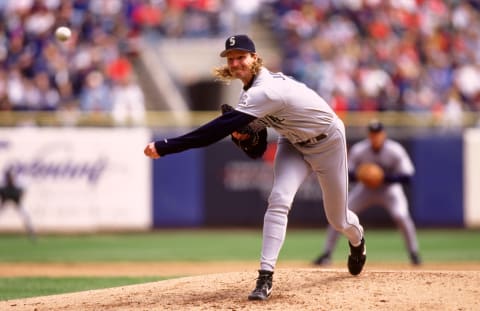
Randy, Pedro and Curt
The 1970s had more 300-strikeout seasons than any other decade. The 1990s come in second. In the 1970s, six different pitchers contributed to the eleven 300-strikeout seasons. In the 1990s, just three pitchers combined for seven 300-strikeout seasons.
Randy Johnson was the first pitcher in the 1990s to strike out 300 batters. After reaching the major leagues with the Montreal Expos in 1988, Johnson was traded to the Seattle Mariners in 1989. He struggled to harness his blazing fastball during his first three seasons in Seattle, when he led the AL in walks three straight years.
It all came together for the Big Unit in 1993. He credits a conversation with the strikeout king, Nolan Ryan, for his breakthrough. Johnson and Ryan spoke before a game in the Kingdome in August of 1992 and Johnson came away from their talk with a better idea of how to control his 6-foot-10 body and how to more effectively go after hitters. After this talk with Ryan, Johnson had a 2.65 ERA and 117 strikeouts in 85 innings over his final 11 starts of the 1992 season.
In 1993, Johnson had the first of his record-tying six 300-strikeout seasons. Of course, the pitcher he tied was Nolan Ryan. Johnson struck out 308 batters in 255.3 innings in 1993. He also had a memorable outing in the All-Star Game that July.
Johnson struck out 329 batters in 1998 and 364 batters in 1999 as he continued to dominate hitters for the rest of the decade. He wasn’t the only one putting up big strikeout numbers, though. In 1997, both Curt Schilling and Pedro Martinez topped 300 whiffs. Schilling struck out 319 in 254.3 innings for the Philadephia Phillies. Martinez sat down 305 batters in 241.3 innings for the Montreal Expos.
Schilling followed up his 319 strikeouts in 1997 with another 300 strikeouts in 1998. He hit the magic mark in his final start of the season when he struck out seven batters in eight innings against the Florida Marlins. It was the Phillies’ 159th game of the season.
In 1999, Pedro Martinez had his second 300-strikeout season when he dominated American League hitters for the Boston Red Sox. He made 313 hitters look silly in 213.3 innings. That’s a strikeout rate of 37.5 percent, which is still the all-time record for starting pitchers with enough innings to qualify for the ERA title. Pedro wouldn’t reach 300 strikeouts again, but Randy and Curt were just getting started.
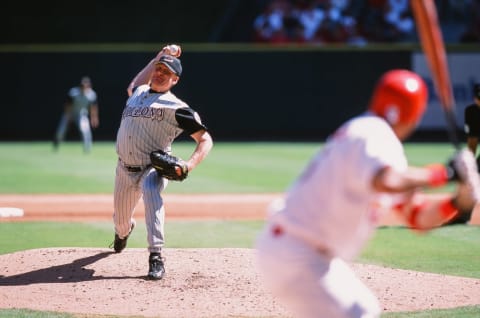
The Diamondbacks Duo
Randy Johnson’s strikeout dominance continued into the next millennium. He struck out 347 batters in 2000, 372 in 2001, and 334 in 2002, which represent three of the top 10 strikeout seasons of all-time. If that wasn’t enough on its own, consider that Johnson was 36, 37, and 38 years old when he was ringing batters up at this prolific pace.
In addition to his six 300-strikeout seasons, the Big Unit had 294 strikeouts in 1995, when the season started late after the 1994 work stoppage. The Mariners only played 145 games that year and Johnson likely missed out on three or four starts. He could easily have had another 300-strikeout season that year.
Johnson had one final shot at 300 strikeouts in 2004, when he was 40 years old. He ultimately came up 10 short and finished the year with 290 strikeouts. Nine years after he last pitched in the big leagues, he ranks fourth all-time in strikeout rate for starting pitchers with at least 1000 career innings.
Johnson’s career strikeout rate of 28.5 percent sits behind three current pitchers, Chris Sale (30.2 percent), Stephen Strasburg (29.0 percent) and Max Scherzer (28.6 percent). Of course, Sale, Strasburg and Scherzer have the advantage of pitching in the highest strikeout era in baseball history.
One other pitcher topped 300 strikeouts in the 2000s and it was a familiar face. When Randy Johnson had 334 strikeouts in 2002, his teammate, Curt Schilling racked up 316 himself. It was the seventh time two pitchers had 300 strikeouts in the same season, but the first time it was accomplished by teammates.
Schilling had an impressive total of three seasons with 300 strikeouts. He also came close one other time when he struck out 293 batters in 2001. If he had been able to strike out another seven batters that season, he and Johnson would have been the first teammates with 300-strikeout seasons a year earlier. As it was, neither Johnson nor Schilling would approach 300 strikeouts again after the 2002 season and the feat wouldn’t be accomplished again for another dozen years.

Clayton, Chris and Max
After Curt Schilling struck out 316 batters in 2002, there was a long stretch without another 300-strikeout pitcher. Even though strikeouts trended up over the next 15 years, it was countered by a decrease in innings pitched by starting pitchers. When Randy Johnson and Curt Schilling topped the 300-strikeout mark in the early 2000s, they averaged nearly 250 innings pitched per season. A pitcher hasn’t topped 250 innings since 2011.
No pitcher struck out 300 batters during the dozen years from 2003 to 2014. Finally, in 2015, we had another member of the 300-strikeout club. Clayton Kershaw sat down 301 batters in 232.7 innings. This was after Kershaw had won three NL Cy Young Awards in the previous four seasons, including back-to-back trophies in 2013 and 2014. In 2015, despite the 301 strikeouts, Kershaw finished third in NL Cy Young voting behind Jake Arrieta and Zack Greinke.
In the year he struck out 301 batters, Kershaw pitched the second-most innings in his career. Since then, he’s averaged just 160 innings per year, although still at an elite level (2.19 ERA, 0.90 WHIP). He’ll be 31 next March and has dealt with injuries in each of the last three seasons, so it’s growing less and less likely that he’ll hit the 300 mark again.
More from Call to the Pen
- Philadelphia Phillies, ready for a stretch run, bomb St. Louis Cardinals
- Philadelphia Phillies: The 4 players on the franchise’s Mount Rushmore
- Boston Red Sox fans should be upset over Mookie Betts’ comment
- Analyzing the Boston Red Sox trade for Dave Henderson and Spike Owen
- 2023 MLB postseason likely to have a strange look without Yankees, Red Sox, Cardinals
The most recent pitcher to strike out 300 batters before Max Scherzer this year was Chris Sale, who sent 308 batters back to the bench in 214.3 innings just last season. He led the league in both categories while going 17-8 with a 2.90 ERA. It wasn’t enough to win the AL Cy Young Award, though, as Corey Kluber took that honor.
Sale struck out 36.2 percent of the batters he faced in 2017, which is the third best rate ever for a starting pitcher in a season. Only Pedro Martinez (37.5 percent in 1999) and Randy Johnson (36.7 percent in 2001) were more whiff-tastic than Sale. Sale also put up the second-best K-BB% in baseball history in 2017. Once again, Pedro Martinez is at the top of the leaderboard in that category.
Should a pitcher win NL MVP?. dark. Next
That’s our countdown of one of the most exclusive clubs in the game of baseball, one that includes Max Scherzer of the Washington Nationals once again!